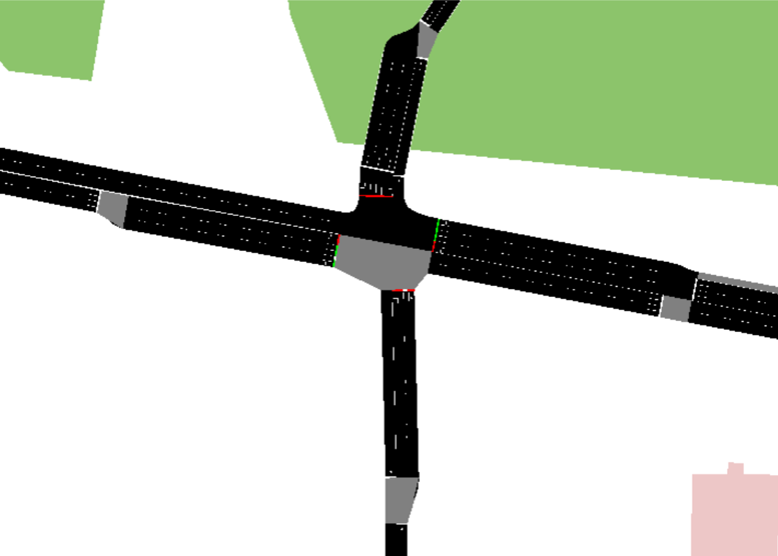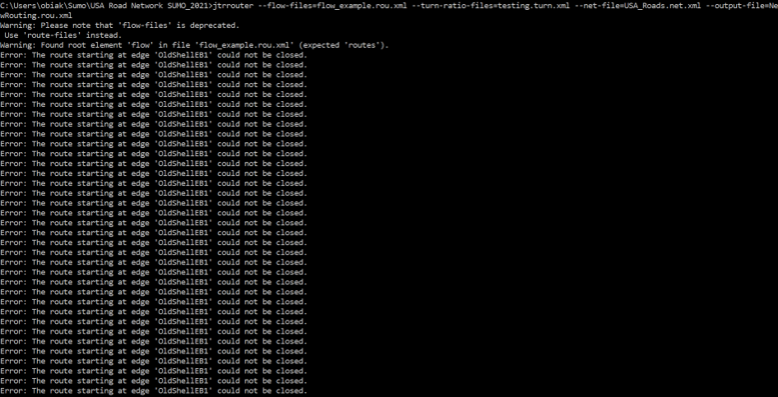Thank you Jakob. That fixed the problem completely. Jtrrouter seems to be running fine now. Sent from Mail for Windows My previous statement "You do not need sinks. In this case all your (routes) may be end "naturally" by running into a dead-end (i.e. network border) or end after using at most 2 times the total number of edges in the network." was incomplete. If you do not define sinks, jtrrouter exits after encountering the "route could not be closed"-error. If you set option --accept-all-destinations the expected number of vehicles is generated. Jakob Thanks, that seemed to fix the problem though I am still getting error messages because of a lack of sink definitions (as per our previous discussions). However, there isn’t a continuous input of vehicles entering the network as prescribed in the flow_example.rou.xml file. I was trying to have an input flow of 1000 vehs/hr entering the network from a simulation time of 0 sec to 21600 sec, but this flow seems to stop at a time of about 300 sec or so. I am not sure what exactly is going on with in this particular case. I assume that this flow (of 1000 veh/hr) is continued over the duration of the specified time, but I don’t think that seems to be the case in my simulation space. Do you know what could be the issue? Thanks Ifezue Sent from Mail for Windows I am wondering what exactly is wrong with my flow_example.rou.xml file. Do I need to impart routes within the flows in the flow_example.rou.xml file? If so, I thought the whole point of jtrrouter was to develop a routes or a rou.xml file. Sent from Mail for Windows Jakob Okay, I am just making sure because I tried replacing the –flow-files with –route-files and expanding the flow definitions in the route-file and I got this error message: 
My route-file looks something like this: 
I am trying to get multiple flows to enter the network at the same time. I tried following this documentation guidance (https://sumo.dlr.de/docs/Demand/Routing_by_Turn_Probabilities.html) since I didn’t know what my destination would be for the vehicles flowing into the network: 
Thanks Ifezue Sent from Mail for Windows You do not need sinks. In this case all your may be either end "naturally" by running into a dead-end (i.e. network border) or end after using at most 2 times the total number of edges in the network. Regarding the outdated option. Just write --route-files instead of --flow-files. I also forgot to ask, what is the appropriate way to use the jtrrouter since the flow-files is outdated? Sent from Mail for Windows Jakob Thanks for the response. I am still a little confused by what you are saying. I understand what you are saying about the sink definitions. However, do I need to have sink definitions added to my turn files to generate a route file? I just went back to my computer and I noticed that a route file was generated any way from what I had shown you previously. Also, for the warning about the “flow-files”, since it is outdated what should be used in its place instead? Is there an alternative to this? Thank you Ifezue Sent from Mail for Windows - the warning about "flow-files" only concerns the option name (the documentation page contained and outdated option name) Hello Everyone I am working with turn probabilities in order to produce routes within my network and I am currently trying to test and see if a flow of vehicles can enter and move through the following intersection successfully. Please know that this is one in a chain of intersections and I am just trying to get the hang of working with jtrrouter by working on this one intersection for now. 
I was able to create flow definitions, a turn ratio file, and network file to generate a routing file for my vehicle in the flow file. Please the files below: Flow definition file: 
Here I followed the instructions for flow definition when the destination is not known within a vehicle’s route. Turn-Ratio File: 
…and of course the net-file is extremely large because it was generated from the OSMWizard. Once aggregated and placed as inputs into jtrrouter to produce a rou.xml file, I got this error message and I am not really sure what is going on. I am not really sure what ‘flow-files’ is deprecated means. Do I need to put turn probabilities for all intersections in my network? Also what does “The route starting at edge ‘OldShellEB1’ could not be closed” means and how can I fix this problem? 
Thank you in advance for the assistance Ifezue Sent from Mail for Windows
_______________________________________________
sumo-user mailing list
sumo-user@xxxxxxxxxxx
To unsubscribe from this list, visit https://www.eclipse.org/mailman/listinfo/sumo-user
_______________________________________________
sumo-user mailing list
sumo-user@xxxxxxxxxxx
To unsubscribe from this list, visit https://www.eclipse.org/mailman/listinfo/sumo-user
_______________________________________________
sumo-user mailing list
sumo-user@xxxxxxxxxxx
To unsubscribe from this list, visit https://www.eclipse.org/mailman/listinfo/sumo-user
_______________________________________________
sumo-user mailing list
sumo-user@xxxxxxxxxxx
To unsubscribe from this list, visit https://www.eclipse.org/mailman/listinfo/sumo-user |







